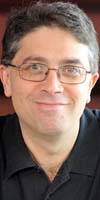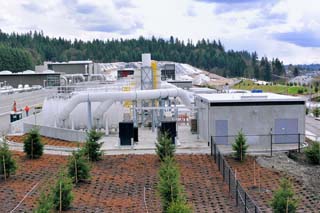|
Subscribe / Renew |
|
|
Contact Us |
|
| ► Subscribe to our Free Weekly Newsletter | |
| home | Welcome, sign in or click here to subscribe. | login |
Construction
| |
 |
July 7, 2011
Brightwater design weds form and function
Mithun

Cryan
|
When the Brightwater wastewater treatment plant opens in September, it will process 36 million gallons per day of treated effluent.
King County and the design team have used this opportunity to create a treatment plant with a strong design unity through the use of select common building features, and to provide employee amenities that will affect cost savings during the operational life of the plant. For Mithun, architect for the facility and for the Brightwater Center, balancing complex needs is a regular part of any design.
For the design of Brightwater — a collection of buildings, tanks, and processes — the team was committed to finding the essential design features for the success of the project. These features provide a positive working environment and strong visual attributes while meeting the technical requirements of the facility.
Daylit spaces
A wastewater treatment facility is an industrial environment. While the processes are critical to the success of the facility, it is the people who work there that keep the combination of natural and mechanical operations flowing. This highlights the importance of creating a positive and healthy work environment.
Many of the tasks performed by staff require them to see clearly, and creating daylit spaces helps the employees complete them successfully. Treatment facilities are often in the open air, but the desire to control odors by enclosing all operations shields employees during bad weather and gives an opportunity to control the daylight in spaces for maximum benefit.
The combination of north and south windows and skylights within the facility allows for even lighting throughout most of the interior spaces. The north and south windows are vertical strips of glass against solid east and west walls, and the light that splays across the interior walls reflects evenly into the space.
The skylights are translucent, controlling the daylight in the space and distributing it into large spaces away from the windows. The skylight effect is repeated in some of the equipment spaces below grade, where large equipment needs to be removed periodically. All the skylights in the treatment areas are removable for replacement of large equipment.
Equipment has been carefully placed based on an ergonomics study produced early in the design. Thoughtful placement created well-planned and easy-to-access spaces that will be easier to maintain — critical at Brightwater, where there will be limited crew and much for them to monitor and control.
The Brightwater design team considered the best routes for professional and educational groups that tour the plant, taking care to avoid disruption of regular plant activities. The team arranged the buildings and integrated the landscape and art throughout the facility to communicate the nature of the site.
Colorful cues
The buildings that house wastewater treatment are often varied in their function and form. Situated sometimes on the lids of basins that are over 300 feet long, the buildings are spaced in a way that makes a consistent visual connection between them difficult.
At Brightwater, the design team established a visual vocabulary of common design elements that appear on facilities as varied as the digester building and the staircase buildings that bring workers to and from subterranean galleries three stories below the ground.
Deep overhangs on the north and south facades of each treatment building organize the roof drainage and unify the buildings that employees access, creating a strong presence among an array of pipes, conduit and odor-control ductwork that crosses the lid of every tank and basin.
The overhangs give the buildings a simple yet strong identity. The overhangs sit atop facades that are a mosaic of metal siding, concrete, tall windows and multiple penetrations of mechanical and electrical service elements.
Walls facing east and west use concrete elements that appear as retaining features, following the natural site contours, holding in the hillside and creating usable flat areas for roadways and site activities. In some instances, these walls become the backdrop for interactive art installations that will be used during tours and featured at a scale that is visible to those visiting the facility or the public park.
The north and south walls also provide opportunities for signature colors to be used in the facility: a strong red at the solids building; a subtle green-gray at the headworks, where all the water comes into the site; and a bright yellow for the membrane bio-reactors and disinfection, where the water is cleaned to a point where it can be reused for irrigation and industrial purposes.
These colorful highlights help visitors and employees get oriented quickly and recognize the buildings and their uses. The exterior palette is repeated in the building interiors alongside elements that can accept color without interfering with the benefits of natural and artificial light.
On the site, large-scale landforms help organize the site into a series of hillsides, each with a particular function. They buffer views and balance the use of soil on the site, ensuring that none of the soil is disposed of in landfills and that greenhouse gas production is greatly reduced.
Brightwater’s architectural design integrates both the form and function needed for the facility’s industrial mission while creating a welcoming environment for visitors and efficient work spaces for employees.
Sean Cryan, LEED AP, is an associate principal at Mithun. With over 25 years of experience, he has spent the last 10 years working on the Brightwater treatment facility and environmental education and community center, from initial programming through final construction administration.
Other Stories:
- Public process helped make Brightwater a reality
- Crews worked quickly to install marine outfall
- Designed to be a good neighbor
- A look around Brightwater
- A place for hands-on environmental education



